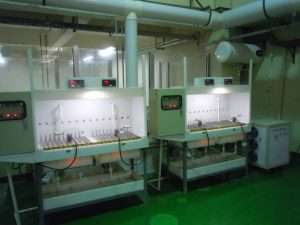Call us now:
Chemical reduction is suitable for the refining of small quantities of crude gold. Oxalic acid (H₂C2O4), SO₂, Na2SO3, FeSO4, FeCl2, etc. can be reduced from gold-containing solutions, of which oxalic acid selectivity is good, does not lead to new impurities, fast reaction speed, in the refining of widely used.
Crude gold is first dissolved with HCI/Cl2 or HCI/NaClO3.
Au +3/2Cl₂+HCI=HAuCl4
or 2Au +2NaCIO3+ 8HCl=2NaAuCl4+ CI₂↑ + O₂↑ + 4H₂O
Boil the solution to drive out the chlorine gas, adjust the pH 1~1.5 with 20% NaOH solution, and add an excess of 1 times of solid oxalic acid with stirring at about 70°C according to the concentration of gold in the solution, and the reduction reaction proceeds intensely.
2HAuCl4+ 3H₂C₂O4=2Au↓+8HCl +6CO2↑
After the reaction is smooth, adjust the solution with alkali and keep the pH=1~1.5, and add an appropriate amount of oxalic acid until the reaction is complete. Later in the reaction, as the gold concentration decreases, the output gold powder may be very fine, and filtered after standing, and the trace gold in the reducing mother liquor is recovered by replacing zinc powder. The output of sponge gold with water diluted twice the HNO, and pure water were boiled and washed, dried and cast ingots, product gold purity 99.9% ~ 99.99%, recovery rate > 99% with ferrous sulfate, sodium sulfite or sulfur dioxide can also be reduced from gold solution at 80 ℃, but will attract new impurities affect product quality.
Translated with www.DeepL.com/Translator (free version)


